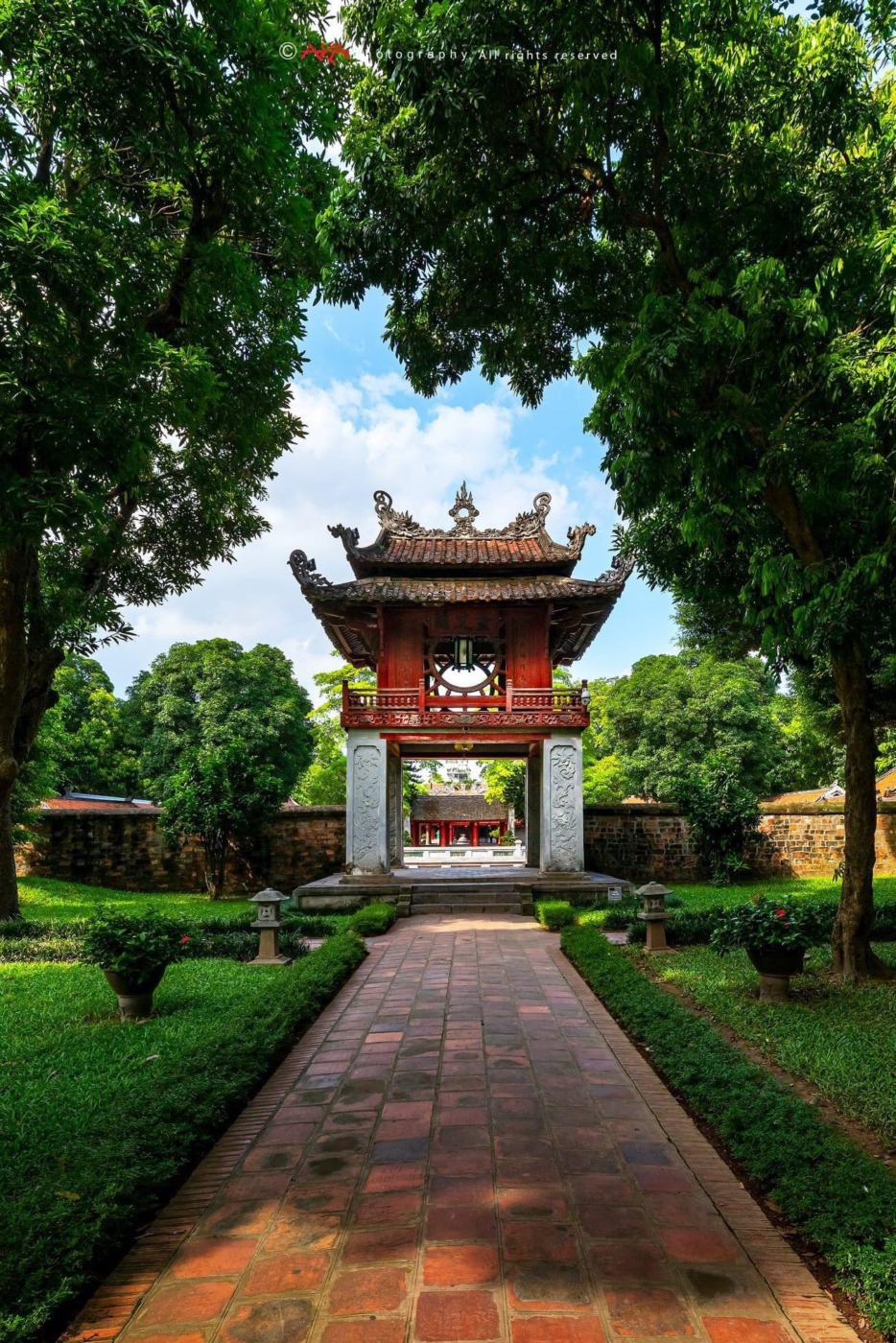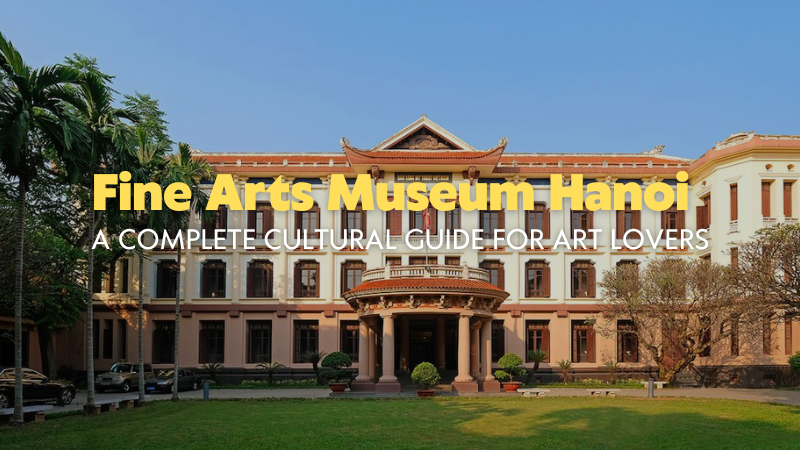If you want to explore Vietnam beyond its landscapes and cuisine, the Fine Arts Museum Hanoi is the perfect place to begin. This museum preserves centuries of Vietnamese artistic heritage—from ancient artifacts and Buddhist sculptures to modern paintings—making it one of the most meaningful cultural stops in the capital. Whether you are an art enthusiast or a curious traveler seeking depth in your Hanoi itinerary, this landmark offers a peaceful yet eye-opening journey into Vietnamese culture.
In this friendly guide crafted by AFS Travel, you’ll discover everything you need to know before visiting, including its history, highlights, practical tips, and nearby attractions worth adding to your day.

Where Is the Fine Arts Museum Hanoi? How to Get There
A Convenient Location in the Heart of Hanoi
The Fine Arts Museum Hanoi sits at 66 Nguyễn Thái Học Street, Ba Đình District, just minutes away from central landmarks like the Temple of Literature, Hoàn Kiếm Lake, and Hanoi Old Quarter. Because of its central position, visitors often pair the museum with other cultural stops nearby.
How to Reach the Museum Easily
Getting here is simple, whether you prefer comfort or budget travel. Taxis and motorbike taxis are the quickest options, and ride-hailing apps make the commute even easier. Budget-conscious travelers can also take several bus routes that pass the museum, such as 02, 18, 22A, 23, 32, 33, 34, 38, 41, 45, or 50. For many visitors, this bus ride becomes a charming way to observe everyday Hanoi life while heading toward one of the city’s best museums.
Opening Hours, Ticket Fees, and Visitor Notes
Operating Schedule
The Fine Arts Museum Hanoi is open daily from 8:30 AM to 5:00 PM. Hours may vary slightly on major Vietnamese holidays such as Tet or National Day, so visitors should check for announcements if traveling during peak seasons.
Ticket Prices
Though affordable, the experience is incredibly rewarding—especially for travelers interested in culture and history. According to feedback gathered by AFS Travel, visitors often spend at least 1.5–2 hours exploring the museum’s many sections.
- Adults: 30,000 VND
- Students: 15,000 VND
- Children 6–16 years old: 10,000 VND
- Children under 6: Free
- Guide service: 150,000 VND
- Parking fee: 5,000 VND
Visitor Tips for a Better Experience
Because many of the artworks are national treasures, guests are advised not to touch exhibits. Photography may be restricted in certain rooms to protect delicate artifacts. Hiring a guide or bringing a booklet helps deepen your understanding of each collection, especially the historical pieces.
The History Behind the Fine Arts Museum Hanoi
From a French Colonial School to a National Treasure
The building that houses the Fine Arts Museum Hanoi dates back nearly 100 years. Constructed in the 1930s, it was originally called Famille de Jeanne d’Arc—a school for daughters of French officers in colonial Indochina. Its distinctive yellow façade and European architectural style still remain, though later renovations added Vietnamese elements reflecting the nation’s identity.
In 1962, the structure was converted into a museum dedicated to Vietnam’s artistic heritage. It officially opened in 1966, showcasing artifacts from prehistoric times to the modern era. Between 1997 and 1999, the museum expanded to accommodate more galleries and educational spaces, becoming the extensive cultural center it is today.
This history alone makes the museum a fascinating destination—an architectural blend of East and West, transformed into a symbol of national pride.
>>> Read more: Cocktail Bars in Hanoi: A Complete Guide to the Capital’s Most Stylish Nightlife Spots
What to Explore Inside the Fine Arts Museum Hanoi
A Rich and Diverse Collection of Vietnamese Artwork
Housing more than 18,000 artifacts, the museum presents Vietnam’s artistic evolution through multiple time periods. Visitors can walk chronologically through ancient tools, historical sculptures, folk paintings, wartime art, and contemporary works.
Art from Prehistoric and Early Historic Periods
The first sections feature ancient tools, ornaments, musical instruments, and figurines that reveal how early Vietnamese communities created art through daily life. These exhibits help visitors understand the foundations of Vietnamese culture centuries before recorded history.
Sculpture and Art from the 11th–19th Centuries
This era marked the golden age of Vietnamese craftsmanship, especially in Buddhist and royal sculptures. Tall, elegant statues from pagodas and temples show the refinement of Vietnamese spiritual art. Many travelers find this section calming, as it reflects Vietnam’s long-standing belief systems and religious traditions.

Art from the 20th Century to Today
This area highlights the shift in Vietnamese art after 1925, when modern techniques and European influences arrived. The galleries also include emotive wartime artworks—paintings, sketches, posters—that depict the resilience and hopes of the Vietnamese people.
Traditional Applied Art and Folk Art
Visitors will encounter textiles, metalwork, bamboo crafts, and iconic Đông Hồ and Hàng Trống folk paintings. These pieces celebrate everyday life, festivals, and legends. They are vibrant, meaningful, and distinctly Vietnamese.

Vietnamese Ceramics from the 11th–20th Centuries
Ceramic lovers will enjoy displays of unglazed and glazed pottery from different historical periods. Famous patterns, colors, and shapes showcase the creativity of Vietnamese artisans across generations.
A Creative Space for Children
Beyond its main galleries, the Fine Arts Museum Hanoi offers an engaging creative zone for young visitors. Founded in 2011 as part of the Fine Arts Education program, this area lets children try painting, making collages, and experimenting with sculpture.
Details for participation:
• Ticket: 50,000 VND per child
• Hours: 9:00–11:30 AM & 2:00–4:30 PM
• Age group: 5–15 years old
Families traveling with kids often find this space refreshing—a hands-on complement to the museum’s more traditional displays.

Landmarks Near the Fine Arts Museum Hanoi
A visit to this museum can easily be combined with several nearby attractions:
St. Joseph’s Cathedral
Hanoi’s oldest church, famous for its Gothic architecture blended with Vietnamese details. It is one of the most photographed landmarks in the city.
Hanoi Opera House
An elegant French colonial building hosting opera, chamber music, ballet, and cultural performances. Its grand interior is a highlight for architecture lovers.
Ly Thai To Monument
A 10-meter bronze statue commemorating the founder of the Ly Dynasty, located close to Hoàn Kiếm Lake. It is both a cultural landmark and a gathering place for locals.
Visitors who want to explore the city more deeply can continue their journey through the Old Quarter, museums, and cultural sites—all within easy reach.
>>> Book now: HA NOI – NINH BINH – HA LONG 4D3N TOUR
Conclusion: Why the Fine Arts Museum Hanoi Belongs on Every Traveler’s Itinerary
The Fine Arts Museum Hanoi is more than just a building filled with paintings—it is a living archive of Vietnam’s artistic and cultural history. Each gallery offers insight into the beliefs, struggles, traditions, and creativity that shaped the nation. Whether you are seeking inspiration, understanding, or simply a quiet break from the busy streets of Hanoi, this museum offers a meaningful experience for travelers of all backgrounds.
With thoughtful guidance and curated recommendations from AFS Travel, your visit will be even more rewarding as you walk through one of the city’s most treasured cultural sites.





















